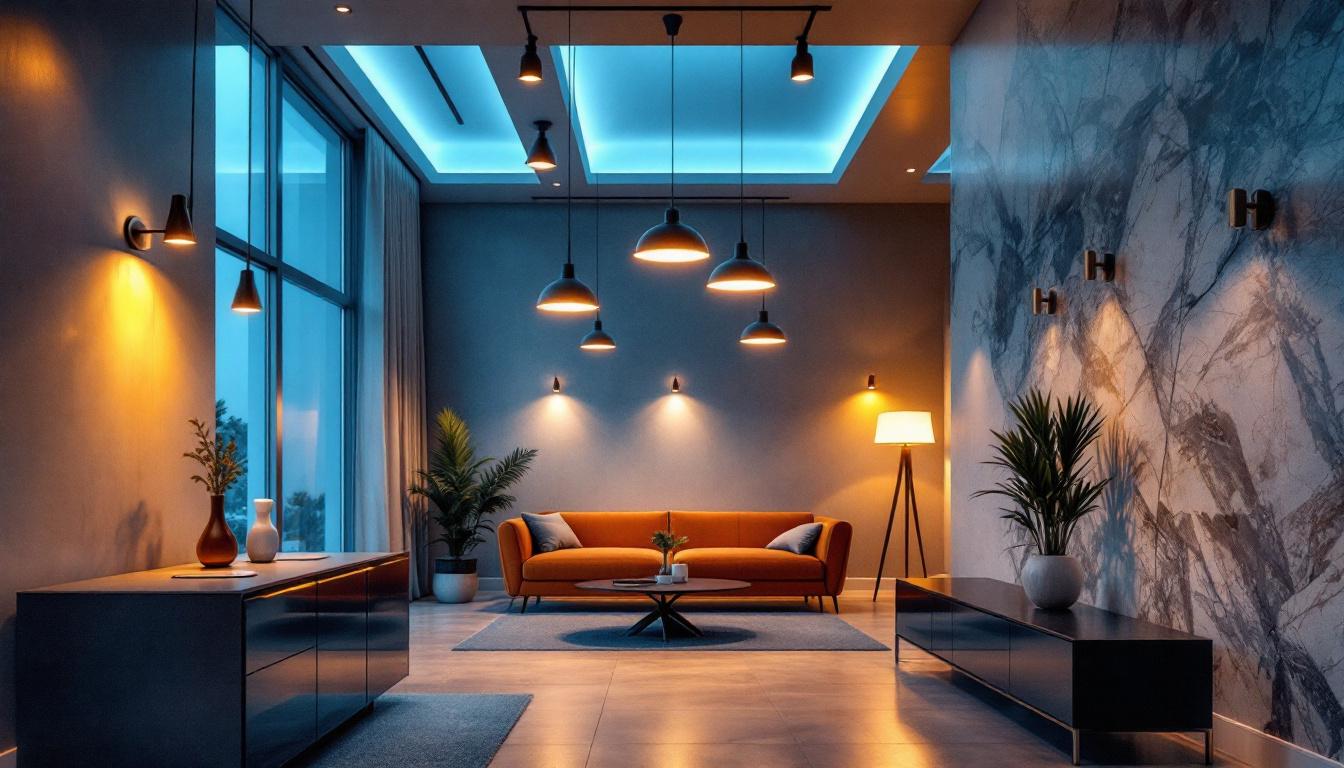
In the competitive world of lighting installations, the term “Porche Light” has emerged as a metaphor for high-quality, efficient, and profitable lighting solutions. While not a technical term, it symbolizes the ideal balance between premium product offerings and strategic business practices that lighting contractors can adopt to maximize profitability.
Lighting contractors face numerous challenges, from fluctuating material costs to evolving client demands. The Porche Light approach emphasizes not only the selection of superior lighting products but also the optimization of installation processes, client relationships, and after-sales services. This holistic perspective enables contractors to deliver exceptional value while enhancing their bottom line.
Moreover, the Porche Light concept encourages contractors to stay ahead of industry trends and technological advancements. For instance, the integration of smart lighting systems has revolutionized the way spaces are illuminated, allowing for greater energy efficiency and user control. By embracing these innovations, contractors can provide clients with cutting-edge solutions that not only meet their aesthetic preferences but also contribute to sustainability goals. This not only positions contractors as forward-thinking leaders in the industry but also opens up new revenue streams through the installation of smart home technologies.
Additionally, the Porche Light philosophy underscores the importance of building strong, lasting relationships with clients. By prioritizing customer service and engagement, contractors can foster trust and loyalty, which are essential for repeat business and referrals. Implementing feedback mechanisms, such as post-installation surveys or follow-up consultations, can help contractors understand client satisfaction levels and identify areas for improvement. This proactive approach not only enhances the customer experience but also solidifies the contractor’s reputation as a reliable partner in lighting solutions.
One of the foundational steps toward maximizing profitability is selecting lighting products that combine durability, energy efficiency, and aesthetic appeal. High-quality fixtures may come with a higher upfront cost, but their longevity and reduced maintenance requirements translate into long-term savings for both contractors and clients.
For example, LED technology continues to dominate the market due to its energy efficiency and extended lifespan. Contractors who prioritize LED fixtures from reputable manufacturers can offer clients solutions that reduce energy consumption by up to 75% compared to traditional lighting. This energy efficiency becomes a compelling selling point, especially for commercial clients focused on sustainability and operational cost reduction.
Additionally, the aesthetic versatility of high-quality lighting products allows for creative design possibilities that can elevate the overall ambiance of a space. From sleek, modern designs to classic, ornate fixtures, the right lighting can transform an environment, making it more inviting and functional. Furthermore, many premium fixtures come with customizable features, such as adjustable color temperature and dimming capabilities, enabling clients to tailor their lighting to suit various activities and moods throughout the day.
Smart lighting systems, which integrate sensors, automation, and connectivity, present significant opportunities for contractors to differentiate their services. These systems allow for dynamic control of lighting environments, leading to enhanced user experience and further energy savings.
By mastering the installation and configuration of smart lighting, contractors can tap into higher-margin projects and recurring revenue streams through maintenance contracts and system upgrades. Moreover, smart lighting is increasingly favored in commercial and residential developments, making it a valuable addition to a contractor’s portfolio.
Furthermore, the integration of smart lighting with other smart home technologies, such as security systems and climate control, creates a cohesive ecosystem that enhances convenience and efficiency. Clients appreciate the ability to control their lighting remotely via smartphone apps or voice commands, which not only adds a layer of comfort but also increases the perceived value of their property. As smart home technology continues to evolve, staying ahead of the curve by offering these advanced solutions can position contractors as leaders in the industry, attracting tech-savvy clients eager to invest in modern amenities.
Efficient project management is critical to profitability. Delays and miscommunications can escalate costs and erode client trust. Lighting contractors who implement robust project management tools and methodologies can better coordinate teams, schedule deliveries, and track progress.
Adopting digital platforms for project tracking and communication reduces errors and accelerates decision-making. For instance, cloud-based software enables real-time updates accessible to all stakeholders, minimizing downtime and ensuring that installations proceed smoothly. Additionally, integrating project management software with inventory systems can provide insights into material availability, allowing for proactive procurement and avoiding last-minute scrambles that can stall projects. By leveraging data analytics, contractors can also identify patterns in project timelines and resource allocation, leading to more informed future planning.
Investing in the skills and knowledge of installation teams directly impacts the quality and speed of work. Well-trained technicians are less likely to make costly mistakes and can adapt more readily to new technologies and complex systems.
Regular training programs on the latest lighting technologies, safety standards, and installation techniques empower contractors to maintain high standards and reduce warranty claims. This proactive approach not only improves profitability but also enhances the company’s reputation. Furthermore, fostering a culture of continuous learning encourages employees to share insights and best practices, leading to innovative solutions that can streamline processes. Mentorship programs can also be established, where seasoned technicians guide newcomers, ensuring that valuable knowledge is passed down and that the team remains cohesive and skilled in the latest industry advancements.
Modern lighting projects often require tailored solutions that address specific client needs, whether aesthetic, functional, or energy-related. Lighting contractors who adopt a consultative selling approach can better understand client objectives and recommend optimal solutions. This method not only involves listening to the client’s vision but also engaging in a dialogue that explores their preferences, budget constraints, and long-term goals. By asking the right questions and actively involving clients in the decision-making process, contractors can ensure that the final outcome aligns perfectly with the client’s expectations.
By positioning themselves as trusted advisors rather than mere installers, contractors can justify premium pricing and foster long-term partnerships. Customization also opens doors to upselling opportunities, such as integrating advanced controls or complementary lighting accessories. For instance, offering smart lighting solutions that can be controlled via mobile apps or voice-activated systems can add significant value to the project. Furthermore, educating clients on the benefits of energy-efficient lighting options not only enhances their experience but also contributes to sustainability efforts, making them feel good about their choices.
After installation, ongoing maintenance and support services provide steady revenue streams and reinforce client satisfaction. Lighting systems, particularly those involving smart technologies, require periodic updates, troubleshooting, and component replacements. Regular maintenance checks can prevent minor issues from escalating into costly repairs, ensuring that the lighting systems operate at peak efficiency. By establishing a proactive maintenance schedule, contractors can demonstrate their commitment to quality and reliability, which can significantly enhance client trust.
Contractors who offer comprehensive maintenance packages can differentiate themselves from competitors and create recurring income. These services also help in identifying new project opportunities within existing client networks. For example, during routine maintenance visits, contractors can assess the client’s evolving needs and suggest upgrades or expansions to their existing systems. Additionally, providing clients with educational resources, such as guides on how to maximize the use of their lighting systems or updates on the latest technologies, can further solidify the contractor’s role as a valuable partner in their clients’ ongoing projects.
Profitability begins with precise cost estimation. Lighting contractors must account for materials, labor, overheads, and contingencies to develop competitive yet profitable bids. Utilizing software tools for cost estimation can enhance accuracy and reduce the risk of underpricing.
Moreover, adopting dynamic pricing models that reflect market conditions, project complexity, and client value perception ensures that contractors remain competitive without sacrificing margins.
Effective inventory management reduces holding costs and prevents project delays caused by stockouts. Contractors who establish strong relationships with suppliers can negotiate favorable terms, access volume discounts, and secure priority deliveries.
Just-in-time inventory practices, combined with reliable supplier partnerships, help maintain cash flow and minimize waste, directly contributing to improved profitability.
A lighting contractor specializing in commercial retrofits successfully implemented a Porche Light strategy by integrating high-efficiency LED fixtures with smart controls in a large office complex. The project emphasized energy savings and user comfort, resulting in a 60% reduction in energy costs for the client.
The contractor’s consultative approach and efficient project management led to a 15% higher profit margin compared to previous projects. Additionally, the maintenance contract secured post-installation ensured a steady revenue stream.
In a high-end residential project, the contractor focused on bespoke lighting designs combined with premium fixtures and automation systems. By offering tailored solutions and demonstrating the long-term value of energy-efficient smart lighting, the contractor commanded premium pricing.
Training the installation team on the latest technologies and maintaining close client communication minimized installation errors and enhanced client satisfaction, resulting in multiple referrals and repeat business.
As sustainability becomes a priority, lighting contractors can expand their services by integrating lighting systems with renewable energy sources such as solar panels. This holistic approach appeals to environmentally conscious clients and opens new market segments.
Understanding the technical and regulatory aspects of such integrations will position contractors as leaders in green building solutions, enhancing profitability through innovative offerings.
Human-centric lighting, which adjusts color temperature and intensity to support circadian rhythms, is gaining traction in workplaces and healthcare facilities. Lighting contractors who stay abreast of these advancements can offer cutting-edge solutions that improve occupant well-being and productivity.
Such specialized installations command higher fees and differentiate contractors in a crowded marketplace.
Maximizing profitability in lighting installations requires a multifaceted approach that combines product excellence, operational efficiency, client engagement, and sound financial management. The Porche Light concept encapsulates this strategy, guiding lighting contractors toward sustainable growth and competitive advantage.
By investing in high-quality products, embracing smart technologies, optimizing installation workflows, and nurturing client relationships, contractors can elevate their service offerings and secure higher profit margins. Staying informed about emerging trends and continuously enhancing workforce capabilities will ensure that contractors remain at the forefront of the lighting industry.
Ready to put the Porche Light strategy into action and drive your profitability to new heights? At LumenWholesale, we’re committed to empowering lighting contractors like you with spec-grade lighting products that don’t break the bank. Say goodbye to local distributor markups and hello to our unbeatable wholesale prices, top-quality selection, and the convenience of free shipping on bulk orders. Elevate your lighting installations with the reliability and performance that only LumenWholesale can provide. Discover wholesale lighting at the best value today and light up your business’s future.

Discover the essential checklist for contractors installing 2X4 lay-in LED light fixtures.

Discover how 4 light LED shop lights can transform your workspace with enhanced brightness and energy efficiency.

Discover how to enhance your home’s lighting efficiency with strategic placement of light fixtures before a double switch.

Discover the essential steps to safely remove ballasts for LED installations and understand why this process is crucial for efficient lighting.